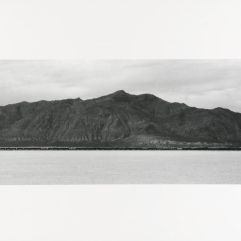

Walter De Maria
1935 - 2013
Walter Joseph De Maria was an American artist, sculptor, illustrator and composer, who lived and worked in New York City. Walter de Maria's artistic practice is connected with minimal art, conceptual art, and land art of the 1960s.
LACMA director Michael Govan said, "I think he's one of the greatest artists of our time." Govan, who worked with De Maria for a number of years, found De Maria's work "singular, sublime and direct".
Life and career
De Maria was born in 1935 in Albany, California. His parents were the proprietors of a local restaurant in Albany and were socially very active, while their son was mostly concentrated on music. Walter De Maria's first academic interest was music-first piano, then percussion. He also took to sports and cars, of which he made drawings. By 1946 he had joined a musicians' union.
De Maria studied history and art at the University of California, Berkeley from 1953 to 1959. Trained as a painter, he soon turned to sculpture and began using other media. In 1960, De Maria and his friends, the avant-garde composers La Monte Young and Terry Riley, participated in happenings and theatrical productions in the San Francisco area. From his exposure to the work of La Monte Young and dancer Simone Forti, among others, De Maria developed an interest in task-oriented, game-like projects that resulted in viewer-interactive sculptures. For example, his Boxes for Meaningless Work (1961) is inscribed with the instructions, "Transfer things from one box to the next box back and forth, back and forth, etc. Be aware that what you are doing is meaningless."
In 1960, De Maria moved to New York City where he married his wife Susanne Wilson (later Susanna) one year later.
His early sculptures from the 1960s were influenced by Dada, suprematism and constructivism. This influence led De Maria into using simple geometric shapes and industrially manufactured materials such as stainless steel and aluminium - materials which are also characteristic of Minimal art. With the support of collector Robert C. Scull, De Maria started making pieces in metal in 1965.
Also in the mid-1960s, he became involved in various artistic activities. His piece, Cage, for John Cage, was included in the seminal 1966 Primary Structures exhibit at the Jewish Museum in New York. He appeared in happenings, composed two musical works (Cricket Music, 1964; Ocean Music, 1968), and produced two films (Three Circles and Two Lines in the Desert; Hardcore, both 1969).
De Maria briefly ran a gallery on Great Jones Street in lower Manhattan with his wife Susanna, showing Joseph Cornell's collection of rare films, Robert Whitman's Happenings (he was then married to and created with dancer/artist Simone Forti), and exhibiting De Maria's Minimalist sculptures made of wood.
In 1965 De Maria became the drummer in the New York-based rock group the Primitives and an artist/musician collaborative group called The Druds. The Primitives included Lou Reed and John Cale and was a precursor to The Velvet Underground.
In 1980, De Maria bought a four-story, 16,400-square-foot Con Edison substation at 421 East Sixth Street, and an adjacent lot at No. 419, between First Avenue and Avenue A. In February 2014, this property was selling for $25 million. Businessman and art collector Peter Brant purchased De Maria's studio for $27 million. Brant's plans for the space were unknown.
The building was developed into the "Brant Art Center," part of the Peter Brant collection. https://www.brantfoundation.org/visit/
De Maria went to California in May 2013 to celebrate his mother's 100th birthday and had a stroke there a few days later. He remained there for treatment. He died in Los Angeles on July 25, 2013, at the age of 77. He was survived by his mother, Christine De Maria; his brother, Terry; four nieces; four nephews; and four grandnieces and two great-grandnieces.
Text courtesy of Wikipedia, 2024







